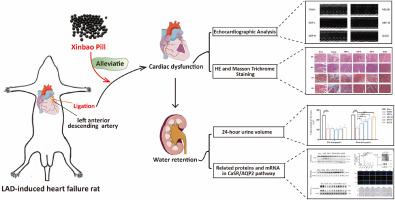心宝丸通过调节CaSR/AQP2通路减轻左心室慢性心力衰竭大鼠的水钠潴留
IF 3
3区 医学
Q1 INTEGRATIVE & COMPLEMENTARY MEDICINE
Journal of Traditional and Complementary Medicine
Pub Date : 2025-09-01
DOI:10.1016/j.jtcme.2024.07.002
引用次数: 0
摘要
地下水潴留是慢性心力衰竭(CHF)发生和恶化的重要因素之一。心保丸(XBP)被广泛用于CHF的辅助治疗。然而,XBP对CHF患者水潴留的治疗作用尚不清楚。目的探讨XBP对CHF水潴留的影响及其机制。方法采用SD大鼠左前降支结扎法建立CHF模型,并给予不同剂量的XBP或七理强心。采用m型超声心动图评估心功能。HE、Masson染色观察大鼠心肌重构和心肌纤维化情况。此外,采用western blotting分析、定量PCR分析、免疫荧光染色、免疫组织化学和免疫共沉淀法检测肾脏中CaSR/AQP2信号通路的表达。此外,利用CaSR抑制剂NPS2143证实了CaSR对XBP保水性的影响。结果在ladd诱导的CHF大鼠模型中,XBP可改善EF(射血分数)和LVFS(分数缩短),减轻心肌纤维化。重要的是,XBP显著增加CHF后24小时尿量,降低尿蛋白水平。进一步的机制研究表明,XBP治疗可在蛋白和mRNA水平上降低肾AQP2的表达。此外,XBP通过上调CaSR和p-p38-MAPK的表达,促进肾AQP2泛素化。同时,XBP通过抑制p-CREB的表达,抑制肾组织中AQP2 mRNA的表达。然而,NPS2143阻断了XBP对心功能和水潴留的有益作用,甚至停止了XBP对AQP2表达的抑制作用。结论XBP通过促进CaSR/p38- mapk介导的AQP2泛素化和调节CaSR/ creb介导的AQP2转录来改善CHF的保水性。本文章由计算机程序翻译,如有差异,请以英文原文为准。

Xinbao pill attenuated water retention by regulating the CaSR/AQP2 pathway in LAD-induced chronic heart failure rats
Background
Water retention is one of the important factors in the development and exacerbation of chronic heart failure (CHF). Xinbao Pill (XBP) is widely used as an adjuvant therapy for CHF. However, the therapeutic effect of XBP on water retention in CHF remains unclear.
Purpose
Our research was aimed to investigate the effect and mechanism of XBP on water retention in CHF.
Methods
Male Sprague-Dawley (SD) rats underwent left anterior descending (LAD) artery ligation to establish the CHF model and were subsequently administrated with different doses of XBP or Qili Qiangxin (QLQX). Cardiac functions were assessed using M-mode echocardiography. Cardiac remodeling and myocardial fibrosis were observed using HE and Masson staining. Additionally, the expression of the CaSR/AQP2 signaling pathway in the renal was detected using western blotting analysis, quantitative PCR analysis, immunofluorescence staining, immunohistochemistry, and co-immunoprecipitation assays. Furthermore, CaSR inhibitor NPS2143 was used to confirm the role of CaSR on the effect of XBP for water retention.
Results
In the LAD-induced CHF rat model, XBP improved EF (ejection fraction) and LVFS (fractional shortening), and alleviated cardiac fibrosis. Importantly, XBP significantly increased the 24-h urine volume and decreased urinary protein level after CHF. Further mechanism studies showed that XBP treatment could decrease the expression of renal AQP2 at the protein and mRNA levels. Moreover, XBP promoted renal AQP2 ubiquitination by upregulating CaSR and p-p38-MAPK expression. Meanwhile, XBP suppressed the expression of p-CREB to inhibit the mRNA expression of AQP2 in the renal tissue. However, NPS2143 blocked the beneficial effects of XBP on cardiac function and water retention, even stopped the inhibitory effect on AQP2 expression by XBP.
Conclusion
Our study revealed that XBP improved water retention against CHF via promoting CaSR/p38-MAPK-mediated AQP2 ubiquitination and regulating CaSR/CREB-mediated AQP2 transcription.
求助全文
通过发布文献求助,成功后即可免费获取论文全文。
去求助
来源期刊

Journal of Traditional and Complementary Medicine
Medicine-Complementary and Alternative Medicine
CiteScore
9.30
自引率
6.70%
发文量
78
审稿时长
66 days
期刊介绍:
eJTCM is committed to publish research providing the biological and clinical grounds for using Traditional and Complementary Medical treatments as well as studies that demonstrate the pathophysiological and molecular/biochemical bases supporting the effectiveness of such treatments. Review articles are by invitation only.
eJTCM is receiving an increasing amount of submission, and we need to adopt more stringent criteria to select the articles that can be considered for peer review. Note that eJTCM is striving to increase the quality and medical relevance of the publications.
 求助内容:
求助内容: 应助结果提醒方式:
应助结果提醒方式:


